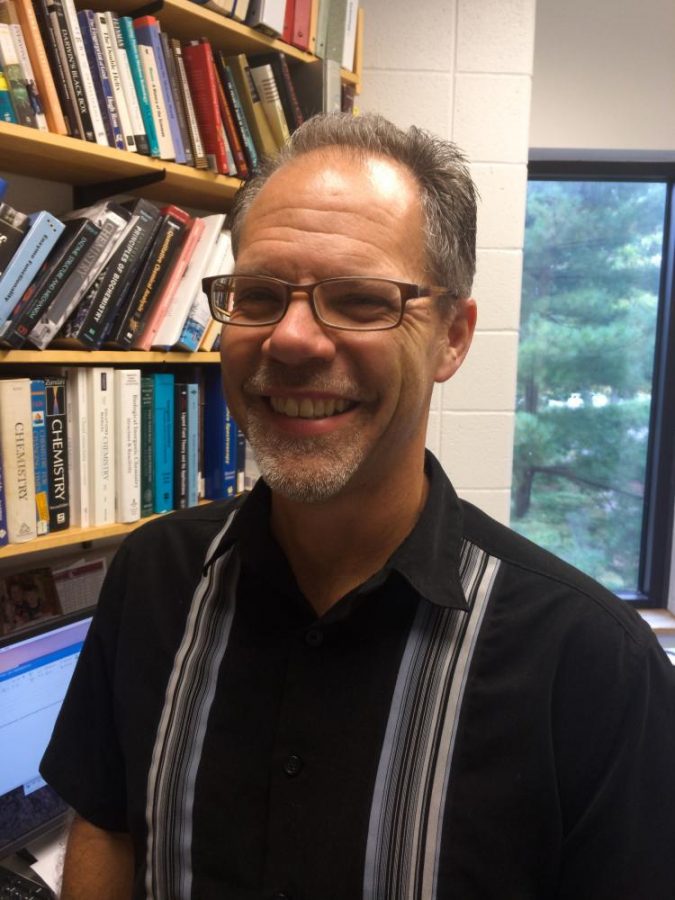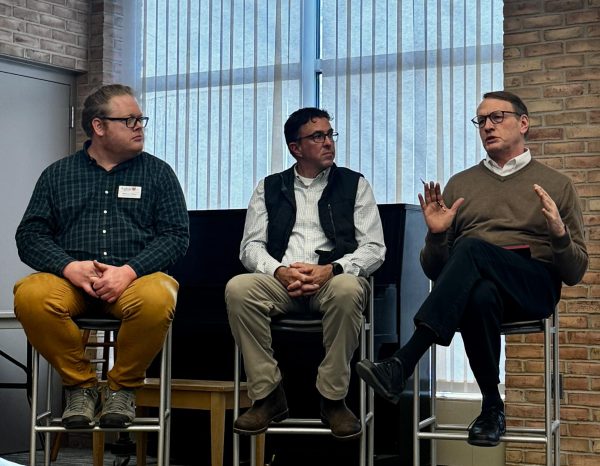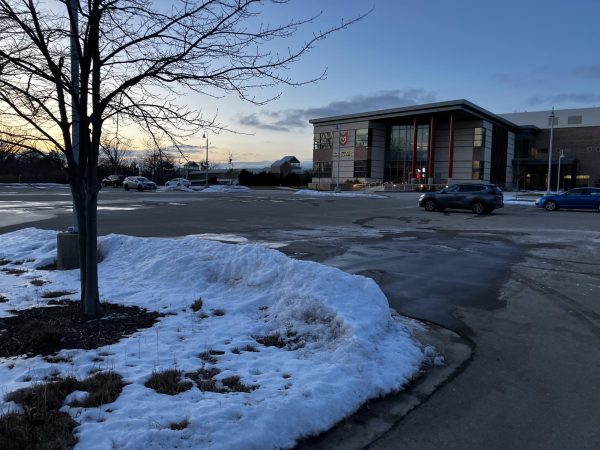Sci sit-down: Q&A with Prof. David Benson
Each week, Chimes is sitting down with science department faculty and students to hear about their research, their aspirations, their fears and the gritty details. This time, Chimes got the chance to talk with Professor David Benson in the chemistry and biochemistry department about his most recent paper.
Benson’s office is much like any other faculty member’s: book-lined, well-used, with a multi-monitor computer setup on a desk stacked with papers. He talks with a zest, equal parts for research and for his students, whom he mentions whenever possible. Benson is deeply embedded in the sciences division, working to care for equipment and serving on a committee which oversees on-campus research. Over the past four summers, he has worked with many students, most recently, senior Adam Hilbrands, junior Elysa Wolf and sophomore Jackson Ross.
Formerly a professor at Wayne State University, Benson is a Calvin faculty member of nine years. He specializes in “bioinorganic chemistry,” a field that focuses on the function of metals in living things. This past summer Benson finalized several years of research and published the findings online just before this school year began.
Chimes: Would you describe your research?
Benson: We’ve worked on what I’ve called proteins as antioxidants. We’re all supposed to eat our fruits and vegetables or have Vitamin C. It’s the secret service person. You don’t want to get it hit with a bunch of reactive oxygen species, some sort of radical species that’s going to modify and goof up your DNA.
The antioxidant is there to take that bullet so that the DNA doesn’t. So the DNA is the president in that analogy and the Vitamin C that you’re supposed to have to thwart any type of disease or common cold is that secret service person.
There are modifications that happen to proteins that basically can do the same thing. They will get oxidized, or take this bullet before something else can. There’s a couple of examples of proteins that do that already and one is the last protein that accepts electrons in our mitochondria, the energy house of the cell. We’re looking at other proteins that might do that. And alternately what we think this is is an additional function for proteins that’s not currently known. We’re trying to, over the next decade, test out whether there’s, instead of a genetic code, there’s an antioxidant code.
Because there’s a lot of cells, a lot of biological cases where cells make strong oxidants as a defense, just like the immune system. You’ve got some foreign body coming in there, whatever that is, and the immune system says, “yeah, that’s a bad actor. We have to get rid of it.”
Basically, it’s spraying peroxide and much stronger oxidants. But now there are proteins that are manufacturing those strong oxidants. How do those proteins survive? Just one example where we think that antioxidant code could be something—an additional safety function that’s being built into that particular protein.
Chimes: Why is it so hard to see this?
Benson: We don’t have the tools. DNA has become really easy because we’ve invested. Really good people in the ‘70s figured out how to solve the initial round of DNA sequencing. Then, in the ‘80s, there was a new method.
Then, in the 90’s, Congress dumped billions of dollars into the Human Genome Project and new sequencing technology came out of that. And now, for a thousand dollars, you can get your entire DNA sequenced. As long as you build the tools, you can study it.
People are trying to develop new tools. The tools just simply aren’t there. There’s one tool or test that people use that’s not a good one, but everybody publishes on it. You basically pull your protein apart, run it through jello, with charges. And you unfold your protein, and it’s this big blob. And this big blob can only go through so fast through these holes. And on average, I’m going to call the blob a sphere.
What this modification does is it takes two amino acid side chains, a backbone of different things hanging off the side. That’s what gives them their function. Well, it turns out that two of those things come together and form a covalent bond, and they are held together. So you can take one end on the protein here and one end on the protein, and they get held together.
So now that blob turns into more like an obloid ellipse and it goes through those pores just a little bit faster. It’s not the greatest assay, but people use it because it’s the only way to test whether [the modification is] there or not. To do some type of measurement of what percent of your protein is converted to this modification.
And then there’s X-ray crystallography where you’ve got to get lots of protein. You’ve got to purify it and then you’ve got to grow it under certain conditions so it becomes this nice pristine crystal, and you ship the crystal to a national lab—there’s like three of them in the country—and you shine X-rays or synchrotron radiation at it and you look at how that X-ray radiation diffracts through that crystal. And you use those projections to figure out a three-dimensional picture.
So there’s fairly simple analysis and really complex, time-consuming analysis. We can’t get any type of percent conversion out of this information. And the information you get out of here is plus or minus 20 percent but you don’t get a good measurement. It’s an ok measurement.
Chimes: What’s been the most challenging bit of the project?
Benson: Almost everything has gone wrong on this project. With that in mind, I’d say just staying flexible and dealing with another setback has been [difficult].
Research is hard. And even trying to get that paper published. We had all the data, but one reviewer said, “No, you’ve got to go back and do these tests to prove these points.” So that was last summer’s research. It was just sort of putting the icing on the cake because somebody wanted icing on the cake.
The hardest part has actually been the joy. Because we just continue to have to think harder, go back to the drawing board, come up with a solution, do something new and see what works, see what doesn’t work.
Chimes: Have students played a role?
Benson: Oh, absolutely. I’ll typically have three to four students working with me a summer. This past paper had off and on probably four summers of researchers involved in it.
It’s about six authors, so a lot of those students will come back for two summers or maybe three summers at that point.
Chimes: What’s next?
Benson: We showed [that] this modification happens in a bacterial protein by making that protein from a different bacterium; E. coli is the bacterium that we made it from.
And then once we made that protein, we put copper in there to do the oxidation chemistry that’s needed to make this modification.
We have no idea what metal makes this modification, or if this modification even happens in the native bacterium—Bacteroides fragilis. That’s the name of that bacterium that exists in our lower intestines and makes up, from what I read, about 25 percent of our poop. It’s rather a poopy project.
We’ve grown that bacterium. I got to harvest that myself this summer. It was a smelly experiment, let’s say.
Chimes: What inspires you about this research?
Benson: It’s fun. What’s fun about it? I love the fact that I can [apply] my love of metal chemistry. I love a single metal ion and the chemistry that it does inside a really complex machine like a protein.
It sort of marries two really cool portions of chemistry together—transition metal chemistry and biochemistry—together to do something that’s really cool. Scientifically, that’s what drives me.
The cool thing for a bioinorganic chemist to do is to go to a number of meetings. Probably the favorite of everybody’s meetings is Metal Ions and Biology [that] meets every January. So you get to see the newest stuff about how oxygen is used, how nitrogen is used and all the cool proteins and enzymes that do it. So it’s a geek camp. My wife laughs at me going out to geek camp. But we’re all geeks together.
The other thing is just getting to work with students, too. I can literally make all my friends at the University of Michigan a bit jealous when I tell them, “I get to go and do experiments and work side-by-side with students.”
And they have other things to do. They’re writing research grants. They’re trying to do some big univeristy stuff too. It’s just a different position, different job. Some of them are like, “Wow, I remember the days when I got to do that. I don’t get to do that anymore.” I still get to do that. It’s awesome.
Chimes: Why this work is worthwhile?
Benson: One, it trains students—science majors—to do science much better. That’s why the national science foundation is really interested in funding all the NSF-sponsored projects here on campus. Even though we’re doing scholarship, we are also teaching and training students much better than what we could ever expect them to learn just in the teaching laboratory.
Second thing is I hope this antioxidant code would have some impact at this point. I realize it’s a basic science problem, but one might imagine that it could have an impact on immunology, allergy and infection; it could have an effect on cancer, there could be some therapies that come from the realization if we show that it’s there. But it is really hard to predict what type of effect this is going to have.
This interview has been condensed and edited.







